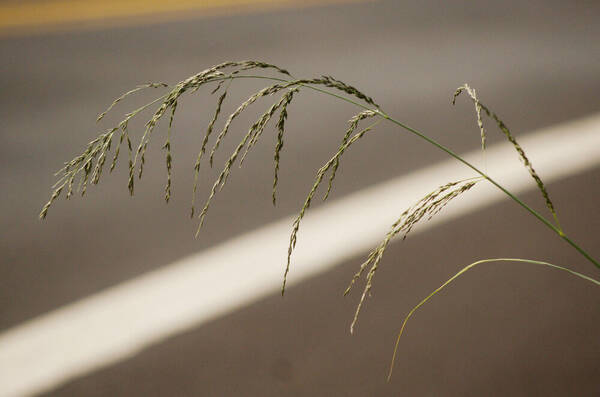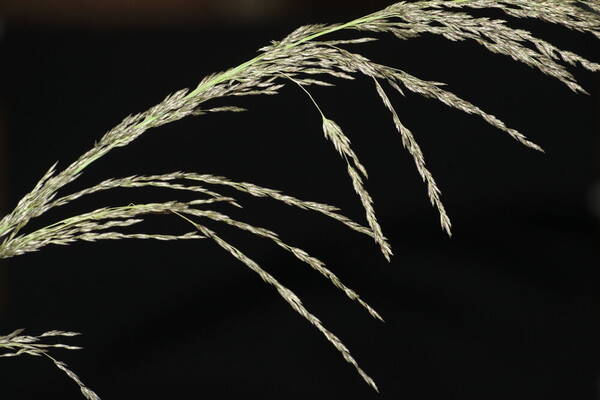Info
Subfamily: Chloridoideae
Genus etymology: Eragrostis = "love grass" [Greek] unclear origin, other etymologies such as "early grass" or "very grass" have also been speculated
Species etymology: curvula = "small bent" [Latin] refering to the curled tips of the leaf blades
Photosynthetic type: C4 (warm season)
Nativity: naturalized - intentional
First recorded in Hawaiʻi: 1989
Map

Inflorescence





Plant

Habit

Spikelets





Culm base


Description
Densely tufted perennial; basal leaf-sheaths strongly striate with the nerves forming prominent ridges, often hard and yellowish, appressed silky hairy below; culms 30–120 cm. high, slender or robust, usually erect. Leaf-blades narrow, up to ± 30 cm. long, 3 mm. wide, usually rolled or filiform. Panicle very variable, loose and spreading to narrow and contracted, 6–30 cm. long, the lowest branches often whorled and hairy in the axils. Spikelets 4–13-flowered, linear, 4–10 mm. long, 1–1.5 mm. wide, grey-green, breaking up from the base, the rhachilla persistent below but fragile above; lower glume lanceolate, 1–1.8 mm. long, 1/3-3/4 as long as the lowest floret; upper glume narrowly ovate, 1.5–2.2 mm. long; lemmas ovate-elliptic, 1.8–2.6 mm. long, appressed to the rhachilla; palea smooth or minutely scaberulous on the keels, persistent; anthers 3, 0.8–1.1 mm. long. Caryopsis ellipsoid, 0.7 mm. long.
(Description source: Clayton, W.D. 1970. Flora of Tropical East Africa. Gramineae (Part 1). Crown Agents for Oversea Governments and Administrations, London. 176 pp. )
Densely caespitose perennial without rhizomes or stolons; culms up to 120 cm tall, slender or stout, firm or spongy, usually erect, sometimes ascending, usually unbranched, rarely branched, glabrous at the nodes, the internodes glabrous or pilose, eglandular; basal leaf sheaths silky-pilose below, coriaceous and hard, the nerves forming close, prominent ridges, terete, eglandular, persistent; ligule a line of hairs; leaf laminas 10–30 cm × 1–3(10) mm, linear to broadly linear, flat or involute, sometimes filiform, straight or flexuous, glabrous to pilose, eglandular.Panicle 6–30 cm long, ovate and loose and spreading to narrow and contracted, the spikelets evenly distributed on pedicels 0.5–4 mm long, the primary branches in whorls below or not, terminating in a fertile spikelet, glabrous or pilose in the axils, eglandular.Spikelets 4–10 × 1–1.5 mm, linear to narrowly oblong, laterally compressed, 4–13-flowered, the lemmas disarticulating from below upwards, the rhachilla persistent, sometimes fragile above; glumes unequal, keeled, glabrous, acute at the apex, the inferior 1–1.8 mm long, reaching to between 2/3 and 4/5 the way along the adjacent lemma, narrowly lanceolate in profile, the superior 1.5–2.5 mm long, reaching to between 1/2 and 3/4 the way along the adjacent lemma, lanceolate in profile; lemmas 1.4–2.6 mm long, keeled, narrowly ovate-elliptic in profile, membranous with indistinct lateral nerves, appressed to the rhachilla, those in opposite rows not overlapping, the rhachilla visible between them, greyish-green, minutely scaberulous, subacute at the apex; palea persistent, glabrous on the flanks, the keels slender, wingless, smooth and glabrous or scaberulous; anthers 3, 0.8–1.1 mm long.Caryopsis 0.7–1 mm long, elliptic.
(Description source: Pope, G.V. (ed). 1999. Flora Zambesiaca. Volume 10. Part 2. Kew, London. 261 pp. )
Plants perennial; cespitose, forming innovations at the basal nodes, without glands. Culms (45)60-150 cm, erect, glabrous or glandular. Sheaths with scattered hairs, hairs to 9 mm; ligules 0.6-1.3 mm; blades 12-50(65) cm long, 1-3 mm wide, flat to involute, abaxial surfaces glabrous, sometimes scabridulous, adaxial surfaces with scattered hairs basally, hairs to 7 mm. Panicles 16-35(40) cm long, (4)8-24 cm wide, ovate to oblong, open; primary branches 3-14 cm, diverging 10-80° from the rachises; pulvini glabrous or not; pedicels 0.5-5 mm, appressed, flexible. Spikelets 4-8.2(10) mm long, 1.2-2 mm wide, linear-lanceolate, plumbeous to yellowish, with 3-10 florets; disarticulation irregular to acropetal, proximal rachilla segments persistent. Glumes lanceolate, hyaline; lower glumes 1.2-2.6 mm; upper glumes 2-3 mm; lemmas 1.8-3 mm, ovate, membranous, lateral veins conspicuous, apices acute; paleas 1.8-3 mm, hyaline to membranous, apices obtuse; anthers 3, 0.6-1.2 mm, reddish-brown. Caryopses 1-1.7 mm, ellipsoid to obovoid, dorsally compressed, adaxial surfaces with a shallow, broad groove or ungrooved, smooth, mostly translucent, light brown, bases often greenish. 2n = 40, 50.
(Description source: Barkworth, M.E., Capels, K.M., Long, S. & Piep, M.B. (eds.) 2003. Flora of North America, north of Mexico. Volume 25. Magnoliophyta: Commelinidae (in part): Poaceae, Part 2. Oxford University Press, New York. 783 pp. http://floranorthamerica.org/Eragrostis_curvula )